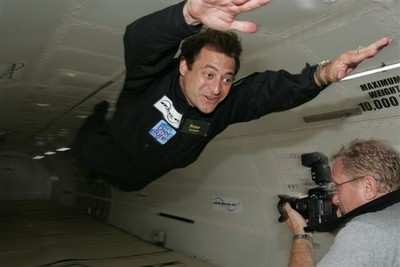May 21, 2017 – Peter Diamandis sent me and others who receive his thoughtful emails the following posting about how ideas can go from crazy to amazing and what it takes to make this happen. The title is a direct quote by the author. Enjoy the read.
I first heard the phrase “the day before something is a breakthrough, it’s a crazy idea,” from Burt Rutan, the man who designed and built SpaceShipOne, the brilliant vehicle that won the $10 million Ansari XPRIZE. As Rutan explained to me, if the breakthrough idea wasn’t considered “crazy” just a few days ago, then it’s not a true breakthrough.
A computer that is 10% or 20% faster is predictable and incremental. Going from vacuum tubes to silicon for computation, on the other hand, is a real breakthrough. This mantra fueled me to push past the criticism for many of my own crazy ideas, ignoring the many “experts” who said it couldn’t be done, and ultimately bending the reality of a future I passionately desired. If I had to name my superpower, it would be persistence (or grit), not giving up, even when everyone was telling me that it wasn’t going to work. In reality, many of my successes have taken 10 years or more to implement.
Here are a couple of stories.
Zero-G
In 1993, I wanted to fly on NASA’s zero-g (KC-135) plane used to simulate weightlessness and train NASA’s astronauts. As much as I tried, NASA turned me down. My response was, “Okay, screw it. If I want to experience it that much, I bet others do as well… I’ll start a zero-g company myself.” So I did. Along with my co-founders, astronaut Byron Lichtenberg, and NASA scientist Ray Cronise, I became CEO of a company called Zero Gravity Corporation, or Zero-G.
Back in May 1993, we had our first meeting with the Federal Aviation Authority. Their response? “YOU WANT TO DO WHAT?”
My answer: “Put 36 people in an airplane, take off their seat belts, put the plane into a parabolic maneuver, 50 degrees nose up, over the top, and then 50 degrees nose down, where they can float in the center of the cabin for 30 seconds.”
This is where my passion hit a bureaucratic decade-long brick wall. It took 11 years of constant pressure, hard work, and outlasting bureaucrats to become operational, which finally happened in September of 2004. Since then, I’m proud to say that we’ve flown over 20,000 people ranging from age 7 to 93, including Professor Stephen Hawking, and wheelchair-bound children into weightlessness. You too can book a flight on the website.
XPRIZE Foundation
I first read Charles Lindbergh’s book, Spirit of St. Louis, in December 1993. I learned that Lindbergh flew from New York to Paris in 1927 to win a $25,000 prize. It was the leverage and efficiency of an incentive prize that led me to propose the idea of a $10 million purse for the first person to build and fly a reusable private spaceship carrying three people into space on two flights within two weeks.
In May of 1996, without the prize money in hand, I went onstage under the St. Louis Arch and announced the $10 million XPRIZE anyway. I thought (mistakenly) that someone would quickly fund the $10 million prize purse. After all, you didn’t pay out the prize money until after a team had successfully completed both flights. Between 1996 and 2001, I pitched 150+ sponsors and received 150 “NOs”. Finally, in 2002, I met the Ansari family, who ultimately funded the $10 million purse (we named it the Ansari XPRIZE in their honor).
Two years later on October 4, 2004, the XPRIZE was won. It took 12 years, from concept to Prize Award. Once again, this was a tale of grit, persistence, and making my own luck. Today, as the XPRIZE Foundation is hitting its stride, at age 24, it has more than $300 million in awarded, funded and designed XPRIZEs.
Two Questions for You:
- Where in your organization do you allow crazy ideas to be funded and attempted? If that doesn’t exist, have you committed yourself to only pursuing incremental improvement? Or do you plan to buy your innovation from the outside world?
- What do you believe in strongly enough that you will dedicate a decade to its pursuit, and be able to withstand 150 ‘no’s’?
At the end of the day, the formula for a true breakthrough is equal to “having a crazy idea” you believe in plus the passion to pursue that idea against all naysayers and obstacles.









